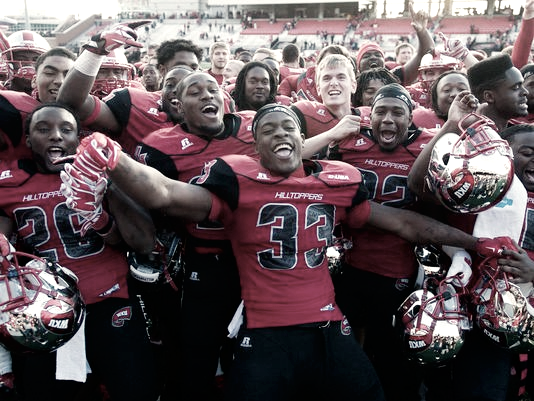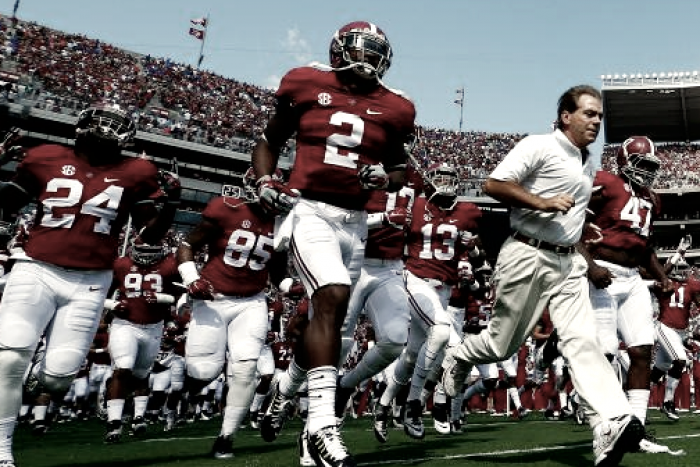With the College Football Playoffs upcoming, there’s been lots of debate on whether the 4-team playoff should be expanded. The majority of college football teams want to see at least eight, if not more, teams with a chance to duke it out to claim the title. Among the expansion, enthusiasts are fans of Penn State, Michigan, and Oklahoma - all two-loss teams that many people believe were more deserving of a playoff spot and should have gotten a shot in the playoffs. In this article, we’ll look at three different expansion ideas, and, using the sports simulator whatifsports.com, we’ll calculate how the playoffs would unravel using each system.
The eight-team system
This seems to be the most logical jump - going from a basic four-team bracket to a simple eight-team setup, single elimination starting in the quarterfinals. Had the system been used this season, we would have had the four original playoff teams - Alabama, Clemson, Ohio State, and Washington, plus Penn State, Michigan, Oklahoma, and Wisconsin. The system would be extremely logical, as it would give top-tier two-loss teams a chance to play for the title. For example, it gives teams a little margin for error in their first couple of games. A prime example is Oklahoma - who started 1-2, including a loss to Houston, who quickly fell off the table. However, the Sooners roared back for nine straight wins, an undefeated conference record, and a Big 12 Championship. People say they're the hottest team in the country, excluding the unbeaten Crimson Tide of Alabama. Who would want to see a matchup of those two teams? A lot of people.
You could argue that a two-loss Big 10 champion - Penn State - is far superior to a one-loss Pac-12 champ - Washington. Well, how about pairing them off in the quarterfinals to see who is the better squad? Give them both a shot at earning the right to face 'Bama in the semis. And, while we're at it, let's toughen the road for the Tide. Give them three games against Top-10 teams to face, just to spice things up a little. An eight-team system this year would have also seen bitter rivals Michigan and Ohio State - who played a double-overtime instant classic a few weeks ago - face off in a knockout quarterfinal round. Does it get any better than that? It's certainly a system worth looking into. And, just to satisfy everyone's curiosity - let's see who runs the table with an eight-team format, had it been used this year.
We decided to hold all the games at neutral sites as, presumably, a playoff expansion would see the quarterfinal games take the place of some of the New Years' Six bowl games.
#1 Alabama 23 #8 Wisconsin 15
Alabama survives the extra challenge, but it gives them a tough test at the start of a playoff run.
#2 Clemson 34 #7 Oklahoma 37
UPSET! The type of game that would thrill people in a potential expansion - the sim has Oklahoma scoring 23 straight points to come back from a halftime deficit and take the win.
#3 Ohio State 24 #6 Michigan 10
It's not a one-possession game, but the world gets to see another installment of the nation's most bitter rivalry.
#4 Washington 33 #5 Penn State 25
The Nittany Lions get the chance to prove themselves, but the Huskies withstand the challenge. The sim has the Huskies racing to a 27-0 lead before weathering a furious Penn State rally.
Semifinals
#1 Alabama 29 #4 Washington 34
This matchup is slated to happen in 10 days. Interesting...
#3 Ohio State 41 #7 Oklahoma 48 (OT)
As said before, Oklahoma might be the hottest team in the country. They would have been capable of making a run.
Championship
#4 Washington 38 #7 Oklahoma 35
This final is impossible this year...but it sounds like a classic. Oklahoma would have been a playoff team, had it not been for a sloppy showing in their first game. Washington? Maybe they've got a better chance than people give them.

12-team system
Another fairly basic system that gives the top 4 teams a bye, leaving room for some fun upsets in the preliminary round, leading into the quarterfinals. This gives a few three-loss teams chances. USC, for example, started 1-3, but they haven't lost since. You can bet they want another shot at 'Bama after losing by 46 in the season opener. The Trojans also beat Washington, giving the Huskies their only loss. Oklahoma State, Florida State, and Colorado all get shots as well. This again increases the margin for error and brings in appealing matchups. Who would want to see a Florida State-Clemson playoff game? How about an in-state Oklahoma State-Oklahoma rivalry. And, while we get to see the FSU-Michigan bowl game...what if there was more on the line than a bowl of oranges? What if say the prize was a quarterfinal berth? This system is another great idea, with more room for upsets and juicy matchups and upset potential. Since there are so many games, we aren't going to comment individually on every game but let's look at each round.
Prelims
#5 Penn State 38 #12 Colorado 18
#6 Michigan 24 #11 Florida State 31
#7 Oklahoma 45 #10 Oklahoma State 40
#8 Wisconsin 23 #9 USC 41
Some people may look at the lopsided score of a few of those games and shake their heads. But let's think about this...last year in the College Football playoff, Clemson beat Oklahoma by 20 and Alabama embarrassed Michigan State 38-0. So the system is already flawed...and at least this one promotes some upsets, like FSU over Michigan, plus a USC victory that gives them another shot at Alabama. This disrupts the initial quarterfinal matchups, bringing in some different teams and even juicier games.
Quarterfinals
#1 Alabama 31 #9 USC 41
#2 Clemson 40 #7 Oklahoma 45
#3 Ohio State 37 #11 Florida State 27
#4 Washington 13 #5 Penn State 27
So, maybe Alabama isn't liking this so far, but, obviously, these are just simulations. In fact, Alabama coach Nick Saban has been a huge advocate of tougher schedules and more playoff teams. You also bring in two more factors with this system: 1. The bye team has more rest. 2. The lower seeded team is coming off a big playoff win so could be playing with more energy. Both are evident as Ohio State claims a win and Penn State reverses the script against Washington.
Semifinals
#5 Penn State 18 #9 USC 35
#3 Ohio State 31 #7 Oklahoma 47
This 12-team system produces some stunning results, again according to the sim. Oklahoma and USC both have pulled out three-straight emotional wins against Top-10 teams. This is what makes March Madness to popular - the low-seeded teams getting a chance to make long runs like this. And then, it culminates in an unexpected final.
Championship
#7 Oklahoma 41 #9 USC 34
An instant classic between two teams that won't get a shot this year, including one that doesn't even make it in the eight-team field. Oklahoma completes a long run that saw them win four tough games to win the title. This should be what makes a championship team. Not a bunch of mediocre wins during the regular season and then just a two-game road to the national title. To be a champ, they should have to prove themselves over three or four games against the best teams in the country. Finally, we'll look at one last system.
16-Team System
This system has something different, though. Rather than taking just the top 16 teams at the Playoff Committee's discretion, this system, similiar to the basketball system, places an emphasis on winning your conference. Winning your conference championship gives you an automatic berth into the playoffs. Now look at this field! The top 10 teams will be the champs followed by 6 at-large bids. The 10 champions will be ranked by the Committee, as will the six at-large bids, creating a four-round playoff system with some true underdog teams that could captivate the country with magical playoff runs. It's this kind of stuff that makes March Madness so popular. Why not give it a shot with football. Doing it this year would give you something like this for a field.
1. Alabama
2. Clemson
3. Washington
4. Penn State
5. Oklahoma
6. Western Michigan
7. Boise State
8. Temple
9. Western Kentucky
10. Appalachian State
11. Ohio State
12. Michigan
13. Wisconsin
14. USC
15. Oklahoma State
16. Florida State
Now you have a very interesting field. Obviously, these rankings are made up, but it mostly uses the rankings of the top teams as they are, with the five non-Power 5 champs thrown in there. You've got 11 big-time programs and five teams that could make things very interesting.
Now, because people would inevitably complain that the matchups are flawed as either Alabama or FSU would be eliminated, while either Western Kentucky or Temple would advance, we'll change that too. The top seed faces the ninth seed, the second seed faces the tenth seed, and so on. After the first round, the quarterfinals will be determined by highest seed versus lowest seed. This forces all the minor conference winners to prove themselves against a traditional top-10 type of opponent.
It rewards every conference champion while bringing every non-conference champion down in the seedings. Ohio State is now seeded 11th, rather than third. It also makes things equally difficult, as now a team like Alabama must prove themselves over four grueling games in order to be called the champion. So let's look at how the first round shakes out.
#1 Alabama 16 #9 Western Kentucky 36
#2 Clemson 31 #10 Appalachian State 17
#3 Washington 34 #11 Ohio State 35 (OT)
#4 Penn State 28 #12 Michigan 33
#5 Oklahoma 48 #13 Wisconsin 29
#6 Western Michigan 17 #14 USC 52
#7 Boise State 38 #15 Oklahoma State 20
#8 Temple 33 #16 Florida State 21
So maybe this simulator really doesn't like Alabama. But, regardless, you've got some interesting stuff going on here. Your quarterfinals now feature three non-Power 5 conference champs - Western Kentucky, Boise State, and Temple.
All three teams were forced to prove their worth with victories over Power-5 teams. They succeeded - others like Western Michigan and Appalachian State failed. But Appalachian State gave Clemson a good game. And while the Broncos were blown out by USC, it's still a smaller margin of victory than the Crimson Tide had in last year's semifinals. And one bad game out of eight, with a few big upsets mixed in? Most people will take that over two semifinal blowouts and one good game over the course of just a three-game playoff.
Quarterfinals
#2 Clemson 24 #14 USC 33
#5 Oklahoma 24 #12 Michigan 37
#7 Boise State 27 #11 Ohio State 31
#8 Temple 19 #9 Western Kentucky 33
Some people will complain that Western Kentucky and Temple got to play each other. Well, that's how it worked out. Both teams proved themselves against Power-5 teams. Western Kentucky is in the semis. Sure, their quarterfinal win was a little weaker, but their first win was over Alabama.
Meanwhile, you've got a classic game between Boise State and Ohio State. For what it's worth, the sim had Ohio State needing a last-minute touchdown to survive Boise State. These games are what could make the playoff great. At the risk of too many comparisons to March Madness, this system gives the possibility of so many upsets. March Madness seems to always have a shocking team in the mix - like ninth-seeded Wichita State in 2013 - a team that went to the Final Four. With this system, you've got a shocking underdog 2-rounds in - and the entire college football world watching to see how far it goes.

Semifinals
#2 Clemson 31 #12 Michigan 48
#9 Western Kentucky 38 #11 Ohio State 33
How about it? Your national championship is something entirely unexpected. You have Michigan versus Western Kentucky. Western Kentucky, in the sim, beat both Alabama and Ohio State, sandwiched around a victory over Temple to get this far. The Wolverines beat Penn State, Oklahoma, and Clemson. With three draining victories behind them, the two squads battle for the title. And, just for kicks, let's see who brings home the title:
#9 Western Kentucky 31 #12 Michigan 54
And while this cinderella story doesn't have a happy ending according to our simulator, this championship is far more interesting and unexpected than what we will get this year, regardless of who wins in the semifinals.
A change in the system certainly makes sense, regardless of which system is chosen. In last year's playoffs, the TV ratings were down 35% in the semifinals and 15% in the title game. The NCAA basketball championship got better ratings than any one of the college football playoff games. The playoff makes things more exciting than the -team BCS format that picked two teams from a computer program. But they can do much better than what they have right now. These ideas are all interesting possibilities that should be explored.
And who knows? Maybe Western Kentucky will win the title next year.








































